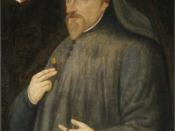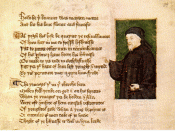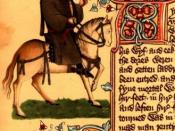In reading Geoffrey Chaucer's 'Canterbury Tales,' I found
that of the Wife of Bath, including her prologue, to be the most
thought-provoking. The pilgrim who narrates this tale, Alison, is
a gap-toothed, partially deaf seamstress and widow who has been
married five times. She claims to have great experience in the
ways of the heart, having a remedy for whatever might ail it.
Throughout her story, I was shocked, yet pleased to encounter
details which were rather uncharacteristic of the women of
Chaucer's time. It is these peculiarities of Alison's tale which
I will examine, looking not only at the chivalric and religious
influences of this medieval period, but also at how she would
have been viewed in the context of this society and by Chaucer
himself.
During the period in which Chaucer wrote, there was a dual
concept of chivalry, one facet being based in reality and the
other existing mainly in the imagination only.
On the one hand,
there was the medieval notion we are most familiar with today in
which the knight was the consummate righteous man, willing to
sacrifice self for the worthy cause of the afflicted and weak; on
the other, we have the sad truth that the human knight rarely
lived up to this ideal(Patterson 170). In a work by Muriel
Bowden, Associate Professor of English at Hunter College, she
explains that the knights of the Middle Ages were 'merely mounted
soldiers, . . . notorious' for their utter cruelty(18). The tale
Bath's Wife weaves exposes that Chaucer was aware of both forms
of the medieval soldier. Where as his knowledge that knights
were often far from perfect is evidenced in the beginning of
Alison's tale where the 'lusty' soldier rapes a young maiden;
King Arthur, whom the ladies of the country beseech to...


